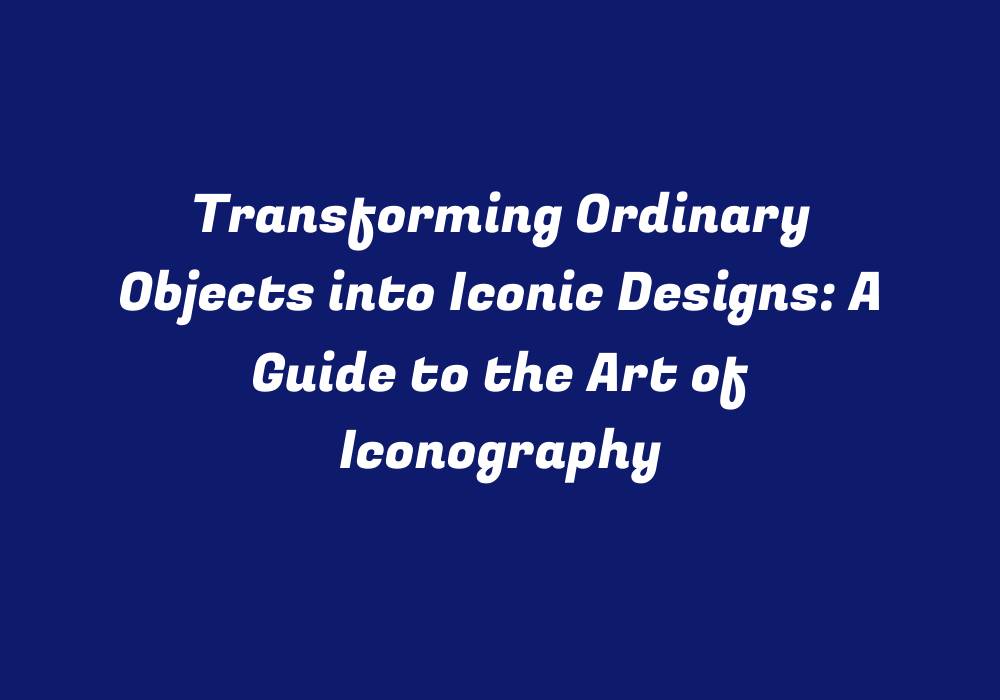Introduction to Iconography: The Art of Turning Ordinary into Extraordinary
Iconography is the art of crafting remarkable designs from seemingly ordinary objects. It’s about transforming mundane items and materials into meaningful, impactful visual statements that capture attention, evoke emotions, and leave a lasting impression. In this article, we will delve into the essence of iconography, explore how it can be applied in various creative fields, and offer some useful tips to help you develop your skills in creating iconic designs.
Understanding Iconography
Iconography is a multidimensional concept that encompasses several aspects, such as design composition, cultural significance, aesthetics, and symbolism. It’s an interdisciplinary field of study that merges art history with graphic design to create visually appealing, evocative visual representations. These icons often serve as a form of communication that transcends language barriers.
Applications of Iconography in Creative Fields
Iconography plays an essential role in numerous creative fields, including:
1. Graphic Design: Logos, branding, and web design are all areas where iconography is used to create a unique visual identity.
2. Art Direction: In film, advertising, and television productions, iconography helps to convey storytelling elements through visual representation.
3. Visual Communication: Iconography enhances the clarity of messaging in infographics, maps, and diagrams by using easily recognizable symbols that simplify complex information.
4. Fashion Design: Iconic designs can be found in fashion accessories, jewelry, and clothing, where they serve as a symbol of individuality or cultural heritage.
5. Interior Design: Space planning, architectural elements, and furniture pieces can all incorporate iconographic elements to create memorable, thematic environments.
Developing Iconic Designs: Tips and Techniques
To develop your skills in crafting extraordinary designs from ordinary objects, you should consider the following tips and techniques:
1. Analyze and Study Iconographic Symbolism: Research existing iconography to understand its origins, meanings, and applications across different cultures and artistic styles. This will help you develop an appreciation for how symbolism can be incorporated into your work.
2. Explore Different Materials and Mediums: Experiment with various materials such as wood, metal, glass, and fabric to create iconic designs from everyday objects. This will help broaden your creative horizons and give you a diverse range of options for crafting unique designs.
3. Embrace Minimalism: Iconic designs often simplify complex ideas into concise visual statements by focusing on essential elements and removing unnecessary details. Strive to achieve clarity in your designs while maintaining their impactfulness.
4. Combine Traditional Techniques with Modern Innovations: Blend traditional craftsmanship, such as woodworking or pottery making, with modern techniques like 3D printing or digital design software. This fusion can lead to the creation of unique, contemporary iconic designs.
5. Collaborate with Artists from Different Disciplines: Team up with artists from other fields such as painting, sculpture, and photography to share ideas and learn new approaches to creating iconographic designs.
6. Keep an Eye on Trends and Cultural Movements: Stay updated with emerging trends in design and society to create iconic designs that resonate with the target audience’s values, beliefs, and preferences.
7. Practice Patience and Perseverance: Creating iconic designs is a process that may require time, experimentation, and refinement before achieving your desired outcome. Be patient and persistent in perfecting your craft.
Conclusion
Iconography offers an engaging and rewarding opportunity to create meaningful visual representations that transcend language barriers. By understanding the concept, exploring its application in various creative fields, and employing the tips outlined above, you will be well-equipped to transform ordinary objects into iconic designs that leave a lasting impression on your audience. Keep honing your skills, stay inspired by other artists’ work, and embrace the joy of crafting unique designs that embody your individual artistic expression.
